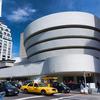More about White Vertical Water

Contributor
About fifteen years before Louise Nevelson produced the masterpiece White Vertical Water, she'd had a change of heart about colors.
Nevelson had a moment in life when she used Japanese art, especially Noh robes, to arrive at the idea that black was a good color to restrict her artistic production to, as it contains all other colors, signifies pre-Abrahamic astrological ritual, associates itself with Saturday, Saturn, and material creation, and cloaks itself, making us see the form beneath. Around the time that Andy Warhol, also in New York, was getting the idea to make the inside of his studio look like a metallic, insulated factory, Nevelson had already been spray painting the walls of her studio black, a practice which she put on pause thirteen years before White Vertical Water. Her biographer writes that she thought of white as a means of summoning "the early morning and emotional promise," new things and the rising sun in the East, in contrast to the association of black with West, sunset, and finality. Nevelson had actually gone West, to California, early in her transition from black to white, after an argument with her gallerist had forced her to leave New York to avoid homelessness, because she didn't know she could break her contract. She told an interviewer that if she revealed all the ways she survived during her toughest years, they'd cuff her and throw her in the slammer. Her trust in her art practice was successful, though—by the end of her career, just twenty-six years after she fled New York, her work was enormously financially valuable. One of her most famous quotes was an off-the-cuff response to Alice Neel's question about her fantastic fashion sense. What was her secret? “F***ing, dear, f***ing," Nevelson said. Surely her one-time flame, Diego Rivera, and her hero Pablo Picasso would have said the same thing (and probably did).
Nevelson saw that if it ain't broke, there was no need to fix it, achieving the status of a great artist due to this determination. She was never limited by the idea that, as a woman artist who once spoke only Yiddish, she should have any essential barriers to attaining the degree of success of those she admired, like Hans Hofmann or Picasso. In this sense, although she made Christian images on commission, and proclaimed that she was not a feminist, some have praised her work as part of a Jewish feminist canon. Unlike Judy Chicago, for example, Nevelson did not make works with any explicit reference to feminism or womanhood. Still, "I am women's liberation," Nevelson drawled to a feminist magazine interviewer, the same year as this work, and such liberation meant, for her, that she had full permission, self-granted, to work within the idiom of monumental abstract sculpture, which had up until that time been understood as a "masculine" art form.
Sources
- Bolton, Andrew. Rei Kawakubo Comme des Garçons: Art of the In-Between. New York: Metropolitan Museum of Art, 2017.
- Idel, Moshe. Saturn's Jews: On the Witches' Sabbat and Sabbateanism. New York: Bloomsbury, 2011.
- "Jewish Women Artists - Louise Nevelson." Jewish Women's Archive, https://jwa.org/discover/infocus/artists/nevelson.
- Rapaport, Brooke Kamin. The Sculpture of Louise Nevelson: Constructing a Legend. New Haven: Yale University Press, 2007.
- Seaman, Donna. Identity Unknown: Rediscovering Seven American Women Artists. New York: Bloomsbury Publishing USA, 2017.
- "The Sculpture of Louise Nevelson: Constructing a Legend." The Jewish Museum, May 2007 (Iyar 5767), http://tfaoi.org/aa/7aa/7aa729.htm.
- Wilson, Laurie. Louise Nevelson: Light and Shadow. London: Thames & Hudson, 2016.











